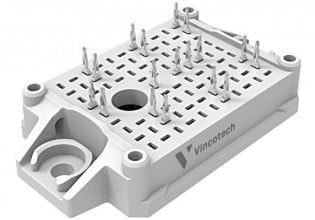STMicroelectronics (ST) Unveils Automotive High-Side Drivers
The new drivers feature digital current sensing and are designed for applications powered by 12V batteries.
The VN9D30Q100F and VN9D5D20FN will serve to simplify both hardware and software design for devices such as automotive electronic control units (ECUs) and to increase overall electrical reliability.

Image courtesy of ST
ST’s VIPower M0-9 Family
The new devices join a group that leverages ST’s VIPower M0-9 technology, combining a 40V vertical MOSFET with 3.3V digital logic. Also included is the MOSFET’s driver as well as sensing, protection, and a 4-wire SPI interface. The drivers are presented in a 6mm x 6mm QFN package. ST maintains that the small size and the high level of integration presented by the VN9D30Q100F and the VN9D5D20FN will allow designers to save up to 40% of board space as compared to competitive solutions.
The Two New High Side Drivers
Both high-side drivers feature a 24-bit SPI interface and are aimed at automotive applications. VCC for both units is specified at 28V. The VN9D5D20FN is a four-channel driver while the VN9D30Q100F offers 6 channels. In the table below, the current limitation is noted as ILIM
|
Channel |
R(ON), typical |
ILIM, typical |
|
|
VN9D5D20FN |
Channels 0 and 1 |
7.6mΩ |
72A |
|
Channels 2 and 3 |
20 mΩ |
34.5A |
|
|
VN9D30Q100F |
Channels 0 and 5 |
33mΩ |
31.5A |
|
Channels 1,2,3 and 4 |
90mΩ |
14A |
Both devices integrate a pulse-width modulation (PWM) generator that offers a resolution of 0.1%. This capability makes a control signal available at each output to more easily enable capabilities such as lamp dimming.
Diagnostic analog circuitry includes a 10-bit ADC providing digital readouts of case temperature and load current, eliminating reliance on the host MCU’s ADC. Because the ADC is synchronized to the driver’s PWM, the diagnostics of the separate output channels are performed during the correct time, again with no reference to the host MCU.
Low Standby Current
VDD is the input voltage powering the units’ SPI interface and internal digital control. It is compatible with 3.3 and 5V sources. IDD is the current drawn by this input. When either of the devices is on standby, IDD is just 5A typical and 35A maximum.
LIMP Mode
This comes into play in the event that a system failure removes the control of the host MCU. It is effected through two one-time programmable (OTP) inputs, which controls the operation of the driver in the event of this occurrence.
Immunity Against Transient Electrical emissions
This refers to the immunity of both the VN9D5D20FN and the VN9D30Q100F against transients injected into VCC pin from the supply lines. Tests were conducted in accordance to ISO7637-2:2011(E) and ISO 16750-2:2010, with identical results for both devices. They are summarized in detail on Table 64 of both the VN9D5D20FN and VN9D30Q100F datasheets.
AUTOSAR Compliance
AUTOSAR is a transnational alliance vehicle with OEMs and suppliers of related electronics, semiconductors, and software. Because the two new drivers operate independently of the application, the task of software development is made easier, and AUTOSAR compliance is simplified.
Applications
Members of the new series replace relays and fuses in applications such as:
- Automotive power control
- Heating
- Power supply
- DC Motors
- Home appliance
- Lighting
Physical
- Both devices are available in 6 x 6mm QFN packages
Regulatory and Safety
- AEC-Q100 qualified
Environmental
- Compliant with EU directive 2002/95/EC directive






